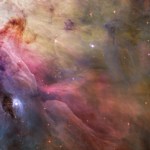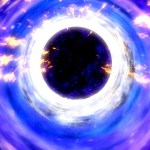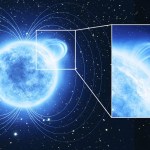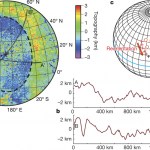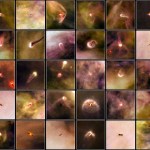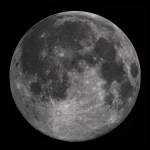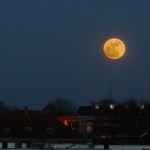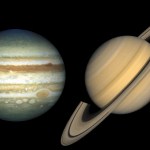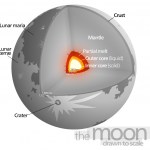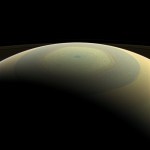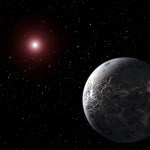Astronomy
“They always say time changes things, but you actually have to change them yourself.” -Andy Warhol
Any week that passes by that leaves you knowing more than when you started is a good one here at Starts With A Bang! I hope this past week didn't disappoint, as many of you became acquainted not only with our latest podcast on parallel Universes, but with some amazing new articles on science and the Universe. Even as the year winds down, there's plenty more to explore! Here's what the past week held:
How do gravitational waves escape from a black hole? (for Ask Ethan),
An X-ray surprise! When…
"We are not the same persons this year as last; nor are those we love. It is a happy chance if we, changing, continue to love a changed person." -W. Somerset Maugham
After 13.8 billion years have gone by, you might not think that a year makes much of a difference. A year to the Universe is like 0.2 seconds -- the literal blink of an eye -- to a human being. Yet even though changes might be gradual, they’re real, and they very much add up over time.
A region of the Orion Nebula, one of the largest and most rapidly-star-forming regions where star birth takes place. Image credit: NASA, ESA and…
"It is worthy of notice that in Table VI the brighter variables have the longer periods. It is also noticeable that those having the longest periods appear to be as regular in their variations as those which pass through their changes in a day or two." -Henrietta Leavitt
The past year has held a slew of victories and defeats, positives and negatives and everything in between for us all. Don’t lament the bad; instead, set yourself up to enter 2017 with something wonderful in hand: an appreciation of the wonder of the natural Universe.
Incredible Stories from Space, and the author with…
"I'll never, ever be full. I'll always be hungry. Obviously, I'm not talking about food." -Dwayne 'The Rock' Johnson
Only a very small percentage of galaxies have active supermassive black holes. While the black holes themselves are common, they only rarely feed, gaining a huge influx of matter to accelerate and send jets and other emission out. When a galaxy does become active, they can appear in any number of interesting manifestations, dependent on their orientation relative to us.
The unified model of AGNs/Active Galactic Nuclei. Image credit: Robert Antonucci, aka Ski, of http://web.…
"I think there are a number of experiments that are thinking about how you could look in different frequency bands, and get a glimpse of the primordial gravitational wave background. I think that would be really revolutionary, because that would be your first glimpse at the very first instant of our Universe." -Dave Reitze, LIGO's executive director
Black holes are remarkable entities that have puzzled and fascinated us since they were first postulated long before Einstein developed his theory of relativity. One of their fundamental but bizarre properties is the fact that once something…
"Science doesn't always go forwards. It's a bit like doing a Rubik's cube. You sometimes have to make more of a mess with a Rubik's cube before you can get it to go right." -Jocelyn Bell-Burnell
Observations that surprise us, of a phenomenon we weren’t expecting and don’t have an explanation for, are some of the most exciting things we can encounter in astronomy. In 1967, regularly pulsing radio sources, discovered without any expectation, provided exactly that. It wasn’t noise; it was definitely a robust, repeatable observation; so what was it?
The data from the first pulsar ever found…
"If a fellow isn't thankful for what he's got, he isn't likely to be thankful for what he's going to get." -Frank A. Clark
There’s a lot to be thankful for, and some of those things are truly universal. The world we share, the Sun we orbit, the galaxy we reside in and the Universe itself plus the laws that govern it are cosmic stories we all share. And if you think about it really hard, you’ll realize that there are a whole slew of cosmic steps that needed to happen that are worth giving thanks to.
An infrared view from ESA’s Herschel observatory of a new star-forming region. Image credit:…
Just as a Chihuahua is still a dog, these ice dwarfs are still planetary bodies. The misfit becomes the average. The Pluto-like objects are more typical in our solar system than the nearby planets we first knew.” -Alan Stern
The Pluto story just gets better and better. Although the flyby of July 2015 lasted only a few hours, the full suite of data taken took 16 months to transmit back to Earth. That finally completed a few weeks ago, and we not only have a complete high-resolution map of Pluto's surface, we also have topological, chemical/molecular and gravitational data covering the surface…
"The new ALMA images show the disk in unprecedented detail, revealing a series of concentric dusty bright rings and dark gaps, including intriguing features that suggest a planet with an Earth-like orbit is forming there." -Sean Andrews
It takes a lot of work to make a solar system from the raw materials of an interstellar molecular cloud, but the Universe is up to the challenge. We had a theoretical picture that held for a long time, but thanks to the array of modern telescopes that humanity has constructed, we've finally been able to put that picture to the test.
30 protoplanetary disks,…
"We only have one planet that serves as an example and in science it's not good to derive information from a sample size of one." -David Grinspoon
Although there will never be a shortage of doubters, the scientific evidence is overwhelming that humans have impacted the planet, particularly over the last few millennia, like no other species ever has. It’s not only the climate that’s changed, but the oceans, atmosphere, freshwater, land use and even the plants and animals that can survive and thrive in the environment. We might be averse to thinking of it as such, but we’re already conducting a…
“If you want your boomerang to come back, first you've got to throw it.” -Steven Hall
If you take all the matter out of the Universe, all you’d have left to warm you would be the radiation from the Big Bang’s leftover glow: the cosmic microwave background. At just 2.7º C above absolute zero, there’s no way of escaping this omnidirectional heat bath, as weak and ineffectual as it might be. Yet right here in our own galaxy, we’ve got an example of something even colder: the Boomerang Nebula.
A millimeter-wavelength view of the Boomerang Nebula. Image credit: NRAO/AUI/NSF/NASA/STScI/JPL-Caltech…
"From out there on the moon, international politics look so petty. You want to grab a politician by the scruff of the neck and drag him a quarter of a million miles out and say, 'Look at that, you son of a bitch.'" -Edgar Mitchell, Apollo astronaut
The full Moon of November 14th may be special for being the closest, brightest full Moon in over 60 years, but every full Moon is full of delightful sights. There’s science behind it, too; much of what you can see even with the naked eye is evidence of our nearest neighboring world’s unique geological history.
The maria -- or seas -- of the Moon's…
"For most people, we often marvel at the beauty of a sunrise or the magnificence of a full moon, but it is impossible to fathom the magnitude of the universe that surrounds us." -Richard H. Baker
This coming Monday, November 14th, 2016, a full Moon will occur extremely close -- within 90 minutes -- of a very, very close lunar perigee. The Moon will come within 356,509 km of Earth while 99.9% full, making this the most “super” Supermoon Earth has seen in 68 years. No matter where you are on Earth, if you have clear skies, it’s worth a look, particularly right before dawn, where it’s at its…
"The evidence at present available points strongly to the conclusion that the spirals are individual galaxies, or island universes, comparable with our own galaxy in dimension and in number of component units." -Heber Curtis, 1920
In many different areas of life, we settle disagreements by popular vote. But in science, we know better; regardless of whether people accept the conclusions or not, the Universe simply is the way it is, and it’s up to us to listen to the evidence to uncover scientific truths. It often happens, however, that everyone can agree on the pieces of evidence, yet disagree…
"To raise new questions, new possibilities, to regard old problems from a new angle, requires creative imagination and marks real advance in science." -Albert Einstein
When we first began looking for exoplanets, we were expecting that other solar systems would be like ours: with inner, small, rocky worlds and outer, large gas giants. What we found surprised us in a couple of ways. Not only could planets of any size appear anywhere, as they seem to, but the most common mass for a planet was somewhere between two and ten Earth masses, something we don’t have a single example of in our Solar…
"This is the plan. Get your ass to Mars, and go to the Hilton Hotel and flash the fake Brubaker I.D. at the front desk, that's all there is to it." -Hauser, Total Recall
There are many locations on Earth that look like they’d be right at home on another world. While from space, it’s incredibly evidence how different Mars and Earth are when you view the entire world, there are places on Earth that are virtually indistinguishable from our red neighbor.
Do these rocky outcroppings over an eroded, sandy valley occur on Earth or on Mars?
I’ve compiled 10 images that look like they could be from…
"The pressure to compete, the fear somebody else will make the splash first, creates a frenzied environment in which a blizzard of information is presented and serious questions may not be raised." -Carl Bernstein
Why is our Moon so unlike every other moon in the Solar System? No other moon is such a large percent of its parent planet’s mass or size; no other moon rotates so far afield of its planet’s rotational axis; no other moon orbits so far out of the planet-Sun plane. Yet our Moon does it all. The giant impact hypothesis might explain why the Moon is made of the same material as Earth,…
“Cassini is different -- it's a mission of enormous scope and is being conducted in grand style. It is much more sophisticated than Voyager, ... I can't say it's got that flavor of romance, though. Voyager was very romantic. Cassini is spectacular.” -Carolyn Porco
It was a big enough mystery when Saturn’s hexagon was first discovered by going back to archival Voyager data, and then confirmed by Cassini. Over the past 36 years, Saturn’s hexagon has not only persisted, it’s remained completely unchanged in size, extent and speed over that time. An artifact of fluid dynamics and the wind speeds…
"This isn't my life anymore, Mulder. I'm done chasing monsters in the dark." -Dana Scully, X-files
One of the most exciting things a scientist can experience is when they look at a sample of data, expecting to not see a particular exciting effect, and yet, something’s there. Immediately, you have to check yourself: what are all the other things it could be? What are the mundane possibilities that could mimic that effect? And what can I do, if anything, to rule them out? Whenever you have a new idea, your main job, first and foremost, is to try and blow the biggest holes in it you possibly can…
"Even if I stumble on to the absolute truth of any aspect of the universe, I will not realise my luck and instead will spend my life trying to find flaws in this understanding - such is the role of a scientist." -Brian Schmidt
Just a few days ago, a new paper was published in the journal Scientific Reports claiming that the evidence for acceleration from Type Ia supernovae was much flimsier than anyone gave it credit for. Rather than living up to the 5-sigma standard for scientific discovery, the authors claimed that there was only marginal, 3-sigma evidence for any sort of acceleration,…

